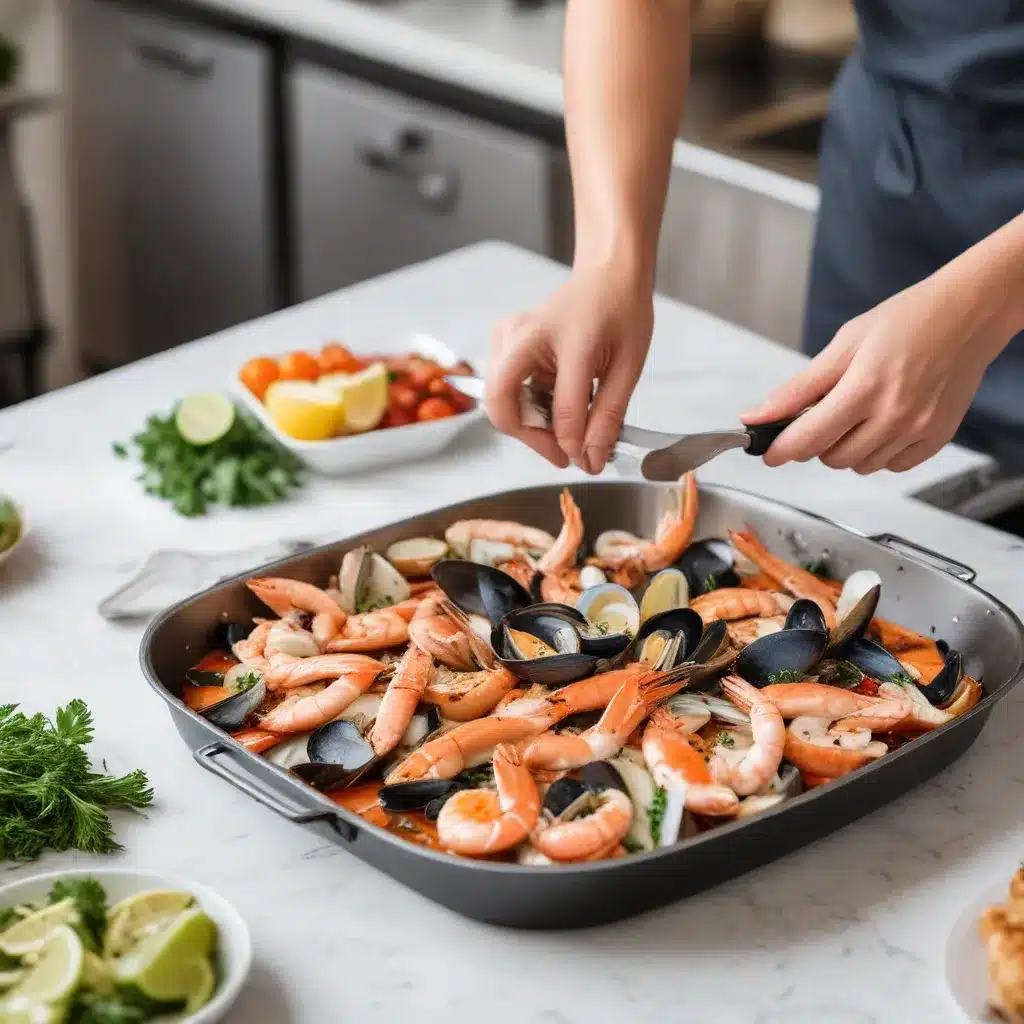
In today’s bustling culinary landscape, where consumers demand both convenience and quality, ensuring the safety and integrity of seafood has become a paramount concern. As a seafood dining expert writing for Fish Tales Cafe, I’m excited to delve into the innovative technologies and time-tested practices that are revolutionizing the way we approach seafood safety in the modern kitchen.
Freshness and Quality Indicators
When it comes to seafood, freshness is of the utmost importance. One of the most reliable indicators of a fish’s quality is its appearance. A fresh, high-quality cod fillet should have a vibrant, glossy skin, firm flesh, and a pleasant, briny aroma. Discoloration, a slimy texture, or a pungent odor are all red flags that the fish may have spoiled.
Proper Storage and Handling
Proper storage and handling are crucial for maintaining the safety and quality of seafood. Fish and shellfish should be kept chilled at the appropriate temperature, ideally between 32-40°F, to inhibit the growth of harmful bacteria. Freezing is also an effective way to extend the fish’s shelf life, but it’s important to follow best practices, such as wrapping the fish tightly in moisture-proof packaging to prevent freezer burn.
Cooking Temperatures and Techniques
When it comes to preparing seafood, reaching the proper internal temperature is essential for eliminating any potential pathogens. The United States Food and Drug Administration (FDA) recommends cooking fish and shellfish to an internal temperature of 145°F. Techniques like sous vide, poaching, or en papillote can help ensure even, thorough cooking while preserving the delicate texture and flavor of the seafood.
Traceability and Transparency
One of the most significant technological advancements in the seafood industry is the development of comprehensive traceability systems. Through the use of Radio Frequency Identification (RFID) tags, blockchain technology, and QR codes, consumers can now access detailed information about the origin, processing, and handling of their seafood, providing unprecedented transparency.
Automated Monitoring Systems
In commercial kitchens and processing facilities, automated monitoring systems are revolutionizing the way seafood safety is managed. These systems can continuously track temperature, humidity, and other environmental factors, alerting staff to any deviations that could compromise food safety.
Data-Driven Decision Making
The wealth of data generated by these technological innovations is enabling seafood producers, distributors, and chefs to make more informed, data-driven decisions. By analyzing trends and patterns, they can identify potential risks, optimize storage and handling procedures, and ensure the highest possible level of food safety.
Sanitation and Cleanliness
Meticulous attention to sanitation and cleanliness is a cornerstone of safe seafood preparation. This includes thoroughly cleaning and sanitizing all surfaces, utensils, and equipment used in the handling and cooking of seafood, as well as practicing proper hand hygiene.
Cross-Contamination Prevention
To prevent cross-contamination, it is essential to separate raw seafood from other food items, use dedicated cutting boards and knives, and ensure that any surfaces or utensils that have come into contact with raw seafood are properly cleaned and sanitized before being used for other food items.
Allergen Management
For those with seafood allergies, proper allergen management is critical. This includes clearly labeling any dishes that contain seafood, maintaining dedicated preparation areas, and closely monitoring for any potential cross-contact during the cooking process.
Food Safety Standards
Seafood safety is heavily regulated by agencies such as the FDA and the United States Department of Agriculture (USDA), which have established stringent food safety standards and guidelines. Compliance with these standards is not only crucial for maintaining public health but also for building consumer trust.
Sustainable Seafood Sourcing
As consumers become increasingly conscious of the environmental impact of their food choices, sustainable seafood sourcing has emerged as a growing priority. By selecting seafood from responsibly managed fisheries and aquaculture operations, we can help ensure the long-term viability of our marine ecosystems.
Seafood Selection and Identification
Educating consumers on how to properly select and identify different types of seafood is an important step in promoting seafood safety. By understanding the unique characteristics of different fish and shellfish, consumers can make more informed decisions and recognize potential safety concerns.
Modified Atmosphere Packaging
Innovative packaging technologies, such as modified atmosphere packaging (MAP), are extending the shelf life of seafood by reducing the presence of oxygen and introducing protective gas blends. This helps to inhibit the growth of spoilage bacteria and maintain the freshness and quality of the seafood.
Intelligent Labeling and Sensors
The integration of smart labels and intelligent sensors into seafood packaging is providing real-time information about the product’s condition, including temperature fluctuations, microbial growth, and spoilage indicators. This allows consumers and food service professionals to make more informed decisions about the safety and quality of the seafood they purchase.
Holistic Approach to Seafood Safety
Ensuring the safety of seafood in the modern kitchen requires a holistic approach that encompasses technological innovations, regulatory compliance, and time-tested best practices. By fostering collaboration across the entire seafood supply chain, we can proactively identify and mitigate emerging threats, continuously improve our safety protocols, and provide consumers with the peace of mind they deserve.
As a seafood dining expert at Fish Tales Cafe, I’m excited to see the continued advancements in seafood safety technology and to work alongside our dedicated team in upholding the highest standards of food safety and quality. By embracing these cutting-edge solutions and proven best practices, we can elevate the dining experience and contribute to the overall well-being of our community.

